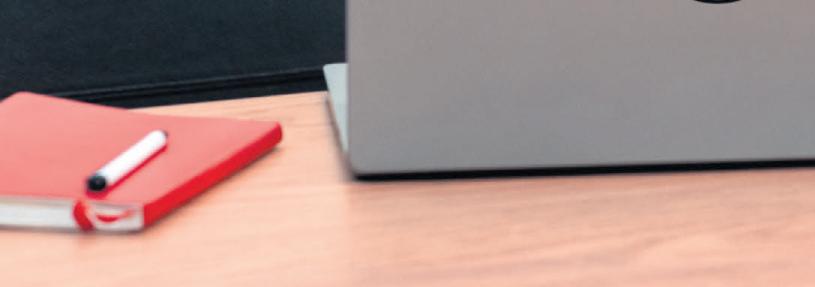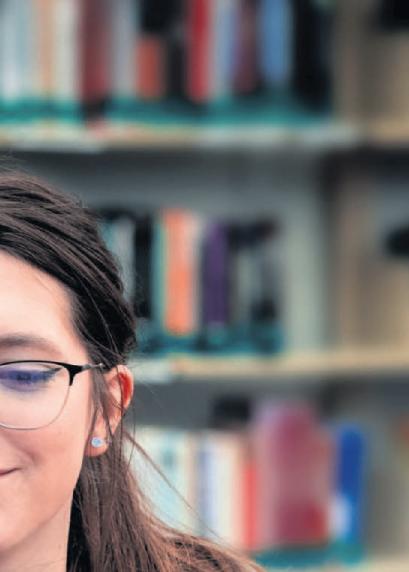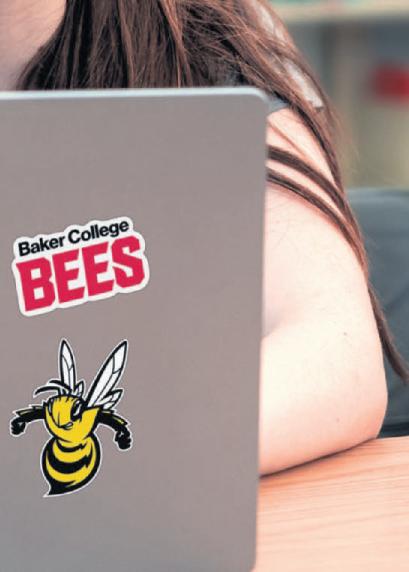







Learn about the many benefits of vocational training along with career opportunities in the agricultural sector and more.


areer CHOICES
Henry Grasman (Computer Engineering, ’24) is more than an aspiring computer engineer – he’s also a patent holder.
Inspired by a workplace challenge he faced during his Co-op at General Motors, Grasman collaborated with his coworkers on an innovative solution that evolved into a groundbreaking system. Henry’s persistence and collaborative spirit eventually led to the patent being approved before he even graduated.
“The real win at Kettering is the chance to push yourself as much as you can,” Grasman said. “You come out of it with a well-rounded set of skills.”
Since its founding in 1919, Kettering
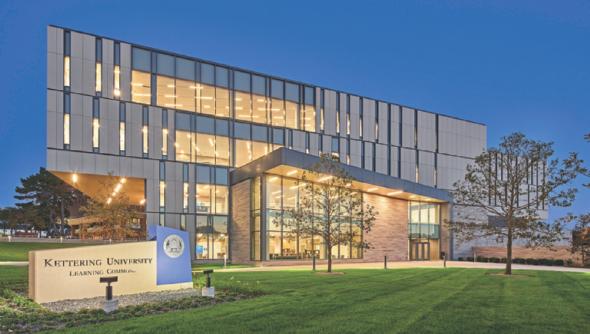
University has brought STEM-focused learning to life through its 50-50 blend of rigorous academics and paid Co-op employment. Unlike a traditional university, Kettering’s curriculum alternates every 11 weeks between a classroom environment and professional employment experience.
Advanced mobility, new energy vehicles, intelligent manufacturing, artificial intelligence and sustainability – the future demands complex, high-tech solutions.
Kettering’s academic programs empower students to test their ideas right away. To push them, break them and rebuild them until they find solutions to tomorrow’s challenges.
With recognized programs in Engineering, Chemical Engineering, Computer Science, Mechanical Engineering, Electrical Engineering, Industrial Engineering, Computer Engineering and Business Management, Kettering produces industry leaders, not just career-ready graduates.
“Kettering University is unique in higher education because we were designed to deliver mastery as an outcome versus simply an education,” said Kettering University President Dr. Robert K. McMahan.
While other colleges offer internships, Kettering leads workforce development with over 400 employment partners in 21 states, including the automotive industry and hundreds of others in the technology and business sectors.
Traditional college internships are typically reserved for juniors and seniors. In contrast, every Kettering student experiences paid Co-op employment twice a year, every year, starting as a freshman.
“That’s the hallmark of what makes our students different,” says Jennifer Umberger, Vice President of Marketing and Communications at Kettering University. “What many schools are trying to do now to differentiate degrees of success is something that has been baked into who we are and how we operate from the beginning.”
Students participating in Co-op programs are more likely to attract job offers above entry level due to their experience. This is one reason why Kettering students earn the No. 1 starting salary in Michigan, according to SmartAsset.
“Kettering helped me future-proof my career by…”
After developing her own versatile set of skills at Kettering and a Co-op experience that took her all over the Midwest, alumna Major Gervé Tillman (Electrical
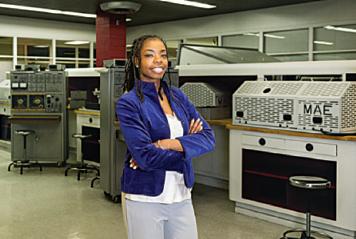
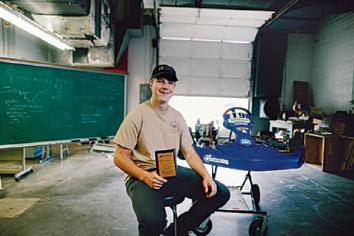
Engineering, ’10; Engineering Management, ’13) took on the role of Program Manager at Space Force, Lead Systems Engineer for the Department of Defense and Commander of the Department of the Air Force Acquisition Instructor Course (AQIC).
“Kettering helped me future-proof my career by preparing me to keep an open mind as the industry, technology and society change,” she said. “The foundational skills I learned from Kettering allow me to continue transitioning and moving forward.”
Despite Maj. Tillman’s commitment to engineering, one of the most impactful skills she took away from Kettering University was blending collaboration with specialization.
“The most important thing I learned at Kettering was the power of relationships,” she said. “Despite coming from different backgrounds or places, if we’re all working toward the same kind of goal, you can learn something from anyone.”
Alumni like Maj. Tillman are living proof that Kettering has built a STEM learning experience like nowhere else. It’s the place where students work shoulder to shoulder with professors and industry leaders, proving what they’re made of, where they solve tomorrow’s problems, put their ideas to the test and develop a versatile set of skills that will always hold value.
The result? They graduate light-years ahead of their peers – and they never look back.
t Oakland University, being golden means shattering the status quo. It’s a rallying cry to believe in yourself – like OU student Irene García Díez, a bioengineering, mechanical engineering, and Spanish language and literature modified major. With the shining support of her professors and peers, she’s pursuing three majors, working as a product engineer intern and embracing roles as a leader, advocate, volunteer and mentor.
In the OU School of Engineering and Computer Science (SECS), students like Irene propel an industry forward. OU SECS’ relevant and innovative undergraduate and graduate programs capture the pulse of changing industry demands and equip students to meet them head-on. Empowered by outstanding faculty in the departments of Computer Science and Engineering, Electrical and Computer Engineering, Industrial and Systems Engineering,
Mechanical Engineering and Bioengineering, Oakland University students exceed their potential amid a thriving community where educational excellence and experiential learning come alive. It’s where professors become mentors and facilitate important connections between theory and practice.
Go beyond the books
Research is at the core of OU’s commitment to a quality education. Even as undergraduates, SECS students stand shoulder to shoulder with faculty in the lab, where breakthroughs and technological advancements connect its curriculum with the world.
Oakland University takes experiential learning seriously. More than 93% of SECS graduates have completed at least one internship upon graduation, fueling the connection between robust academic programming and hands-on learning.
Located in Greater Metro
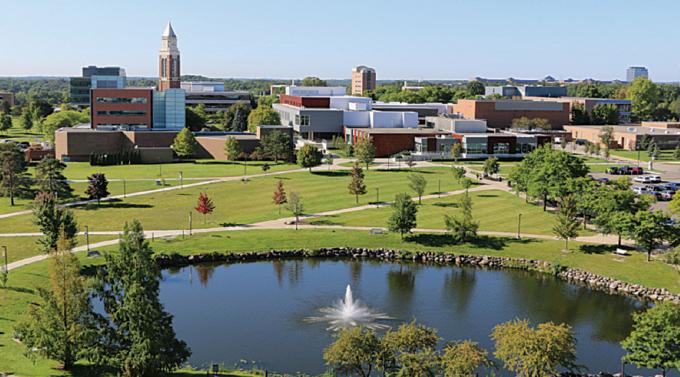
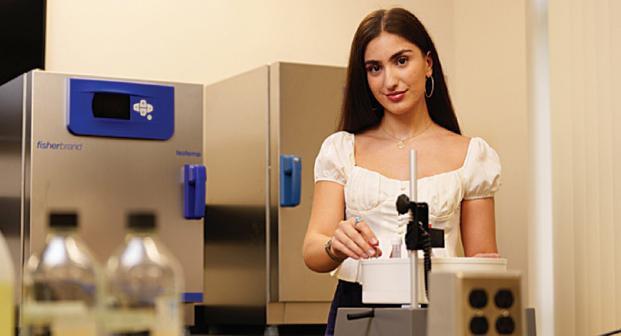
Detroit, Oakland University is an epicenter of opportunity. By forging relationships with hundreds of businesses, OU connects students to their community, career and beyond. In fact, 99% of SECS graduates work in Michigan, powering the region through innovation and excellence acquired through their cutting-edge OU education.
Build a strong foundation
OU is a public doctoral research institution that promotes a global perspective amid an inclusive, closeknit community. With more than 275 undergraduate and graduate programs, including certificates and endorsements, they empower more than 16,000 students with experiential education and diverse opportunities. OU’s 17:1 studentto-faculty ratio enhances studentcentered, personalized instruction.
Oakland University prides itself in offering flexible class schedules, state-of-the-art facilities and supportive student services on a campus infused with academics, arts and Division I athletics.
OU provides easy-toaccess academic resources and advising appointments focused on individualized support to ensure academic success. To boost a strong college launch, every first-year student and undecided transfer student receives extra support and guidance through their first year.
Take advantage of financial aid
Everyone deserves access to an
outstanding education. That’s why OU strives to make an exceptional education affordable. Oakland University creates pathways of opportunity for all students, and offers free tuition for up to four years to eligible incoming Michigan freshmen. OU’s Golden Guarantee works in combination with the Michigan Achievement Scholarship, OU merit and need-based aid to help cover both tuition and other costs, such as housing and living expenses. More than 70% of all OU students receive some sort of financial assistance — including scholarships, grants, work-study and student loans — totaling more than $200 million annually.
Get involved
College is more than getting a degree. It’s that golden feeling of home when you are on campus. It’s pursuing your purpose and finding your people. On OU’s close-knit campus, you don’t get lost in the shuffle. Explore your journey with countless opportunities, like joining a student organization or volunteering in the community — and make memories that last a lifetime.
Your future is golden
Get a feel for our college community and learn what Oakland University is all about by visiting the beautiful campus in Rochester. With a variety of in-person events and student-led tours, you can find the experience that best fits your schedule and interests. Visit oakland.edu/visit to start your journey.
student examples prove you can go anywhere with Montcalm
Haley Powers, of Sand Lake, transferred from Montcalm Community College to Grand Valley State University with 29 college credits she earned while in high school, and she saved thousands of dollars on tuition and fees.
Emily Putman, of Stanton, is playing basketball at MCC, where she plans to study business management. She said she’s excited to continue her basketball career at the college level while continuing her education.
Meg Martin, of Goshen, Ind., earned her Associate of Science and Arts degree with high honors from Montcalm Community College in December 2021 and transferred to Ferris State University where she completed her bachelor’s degree in business administration.
Joseph Normand, of Morley, came back to MCC as a nursing student after working in health care for more than 12 years.
What do you have in common with these students?
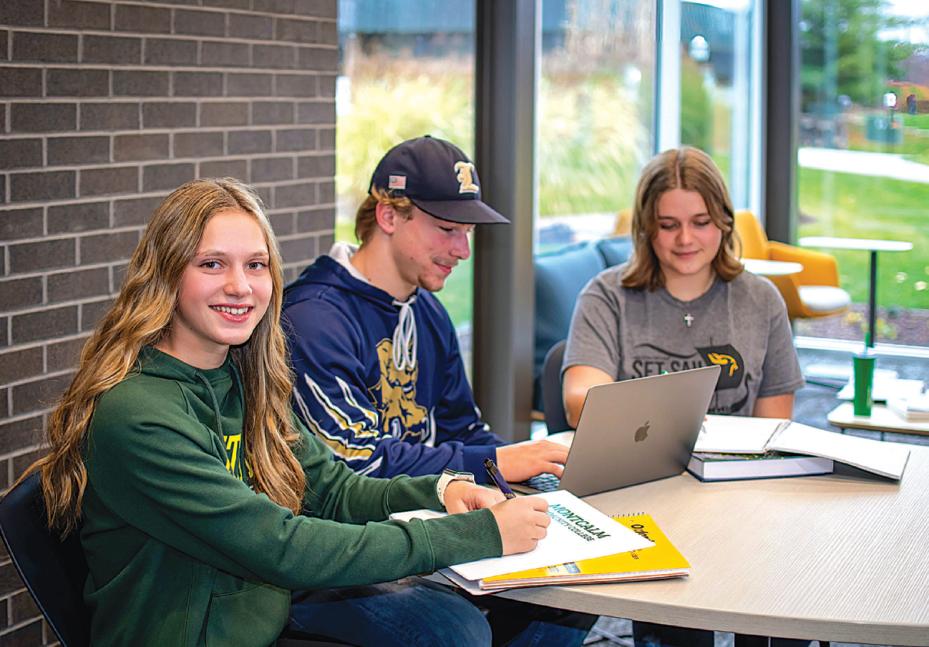
You can do it, too, at Montcalm Community College (MCC).
With two campuses – in Sidney and Greenville – as well as online learning options, there are endless opportunities for students of all backgrounds and geographic locations to start or finish their college education at MCC.
Community is our middle name at MCC, where we have served learners for nearly 60 years.
While education has changed over six decades, our fundamentals remain the same in our mission of “Transforming Lives Through Quality Education.”
MCC offers learners of all ages opportunities to earn credits for degrees, certificates, job training programs or transfer to gain skills leading to jobs in high-demand, high-wage career fields. We offer occupational programs, transfer programs, dual enrollment and Early College programs for high schoolers, and workforce and industrial training, as well as noncredit lifelong
learning opportunities. Our students can take advantage of transfer options through the Michigan Transfer Agreement and more than 125 articulation agreements with four-year universities, which provide seamless transfer of credits.
Perhaps you just want to take a class to brush up on a particular skill, such as
“Every class that I took through MCC was always an extremely positive experience.”
accounting or marketing or college English? Want to dip your toe into a skilled trade? Maybe you’re interested in welding or robotics and you want to take a basic class? You can do that, too, at MCC.
MCC faculty and staff are committed to helping students succeed. With an average class size of 15, our students get personalized instruction in a
variety of subject areas from faculty who are among the best in their fields. Our students are challenged and rewarded by our coursework, with faculty using the latest and most innovative teaching methods in all of our 50-plus program areas.
“MCC just made sense,” Normand said. “I know I have gotten a better education here because of the smaller class sizes. I’m not just a number, and I know my professors on a first-name basis.”
“The whole MCC experience gave me insight as to what college would be like without being thrown in all at once,” said 19-year-old Powers, who added that her favorite experience was being able to form relationships with her instructors and being able to refer back to them for advice and recommendation letters.
“Every class that I took through MCC was always an extremely positive experience,” she said
continued | pg 5
continued | from pg 4
Student support services include academic and career counseling, tutoring, testing and accessibility.
The annual tuition at MCC is a fraction of the cost of a private college or fouryear university, yet we prepare our students for the same careers and provide the same opportunities for success.
Plus, the MCC Foundation offers more than $400,000 in scholarships and aid annually to support our students.
Are you an athlete?
Centurion Athletics has returned to MCC. We’re a member of the National Junior College Athletic Association (NJCAA) and the Michigan Community College Athletic Association (MCCAA).
This year, we had athletes competing in a variety of sports and we’re currently recruiting for all teams. Our offerings include:
• Men’s and women’s basketball
• Men’s and women’s bowling
• Men’s and women’s clay target shooting
• Men’s and women’s cross country
• Men’s golf
• Women’s volleyball
Want to learn more about Centurion Athletics? Visit montcalm.edu/athletics, email athletics@montcalm.edu or call Athletic Director Hunter Redman at 989-328-1095.
For more information about becoming an MCC student, visit montcalm.edu, email studentservices@montcalm. edu or call 989-328-1277.
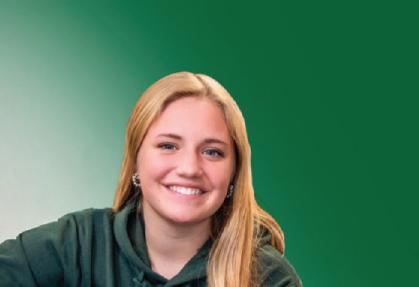

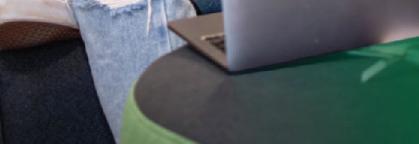
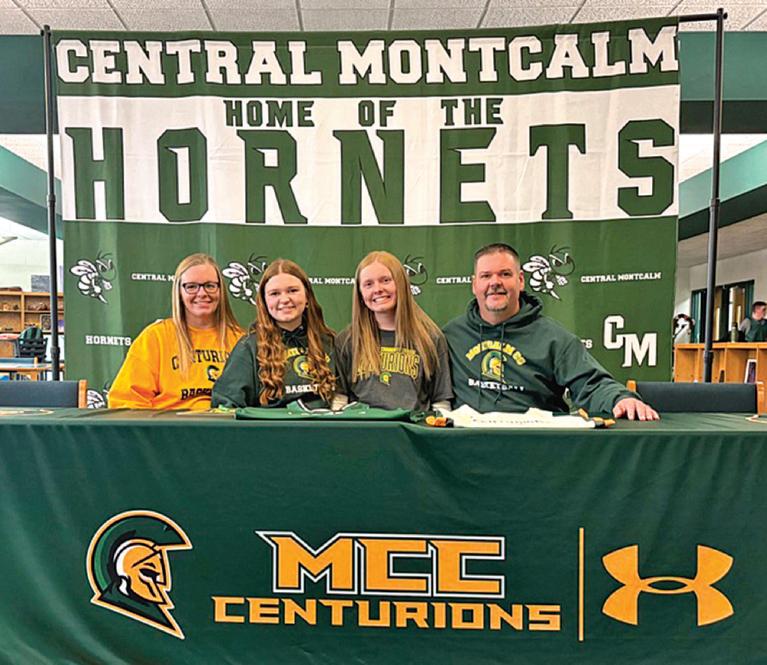

Schools continue to evolve and change their curriculum to meet the needs of modern students. Many schools now recognize the importance of helping students develop skills that will help them be competitive in the world and workforce. One way they are doing so is through the development of educational academies or specific academic tracks to give students an advantage later in their academic careers. Here’s a close look at such offerings, which tend to be primarily at the high school (secondary school) level.
Early college academy, also known as early college high school, is a program that enables high school students to earn two-year associates degrees at the same time as they earn high school diplomas, according to U.S. News & World Report. The Early College High School Initiative was established in part in 2002 by the
Bill & Melinda Gates Foundation. Early colleges have expanded over the last 20 years, and these programs may work in different ways. Some bring high schoolers to college campuses to take courses inperson, or there may be remote course offerings. Others provide college courses in a high school setting. High schools develop complementary relationships with accredited colleges in the area, typically community colleges. Upon completion of the programs, students in the early college courses will receive associates degrees. Advantages to an ECA is that students already have completed two years of college, which saves time and money.
High schools have been offering this option for some time now. Dual enrollment classes are essentially college courses that high schoolers take while in high school. Professors from nearby colleges may teach these courses right in

a high school classroom. High school teachers also may be trained to instruct a college’s approved coursework. At the end of the course, the student will have received credits for that college course. Advanced placement (AP) classes are classes with college-level curricula created by the College Board. AP students must pass AP exams at the end of the classes. Certain colleges will accept AP classes as college credit depending on students’ scores on the tests. Both of these avenues may help students earn college credits, provided the school they attend will accept the credits.
Students may choose to follow particular tracks in high school if they pick a college major or choose a trade school.
Sometimes these programs are called pathways. Nevertheless, they may be offered in Visual Arts, STEM, Business Management, Automotive Repair, Hospitality, or Mathematics. While students will still get an array of core classes, by enrolling in a track, their electives and certain other classes may be geared toward a particular pathway. For example, an eligible math course for a business student may be accounting as opposed to calculus for a general education student. These pathways help develop passions and interests and enable high schoolers to grow accustomed to the customization of a degree.
High school has evolved to introduce students to higher education in novel ways.
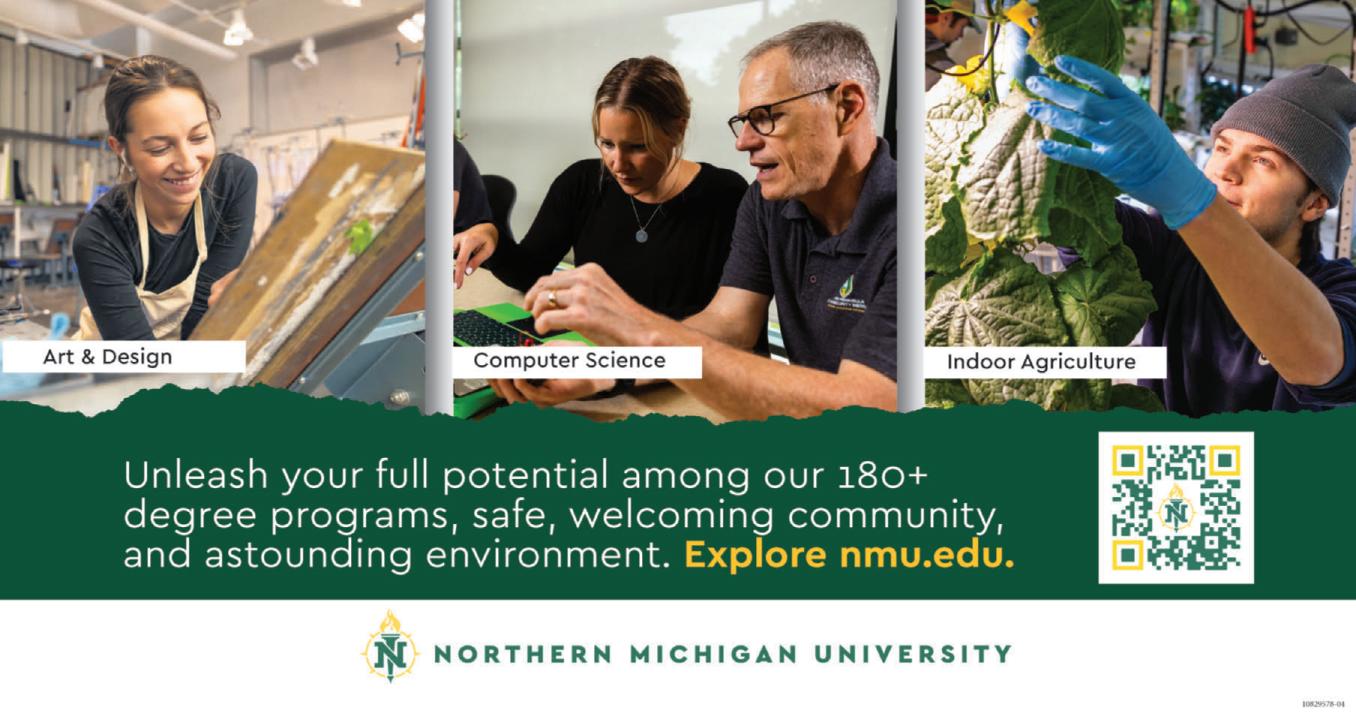
Programs designed for both direct entry into hot careers and university transfer
Flexible scheduling and convenient online or in-person classes
Committed to diversity, equity and inclusion
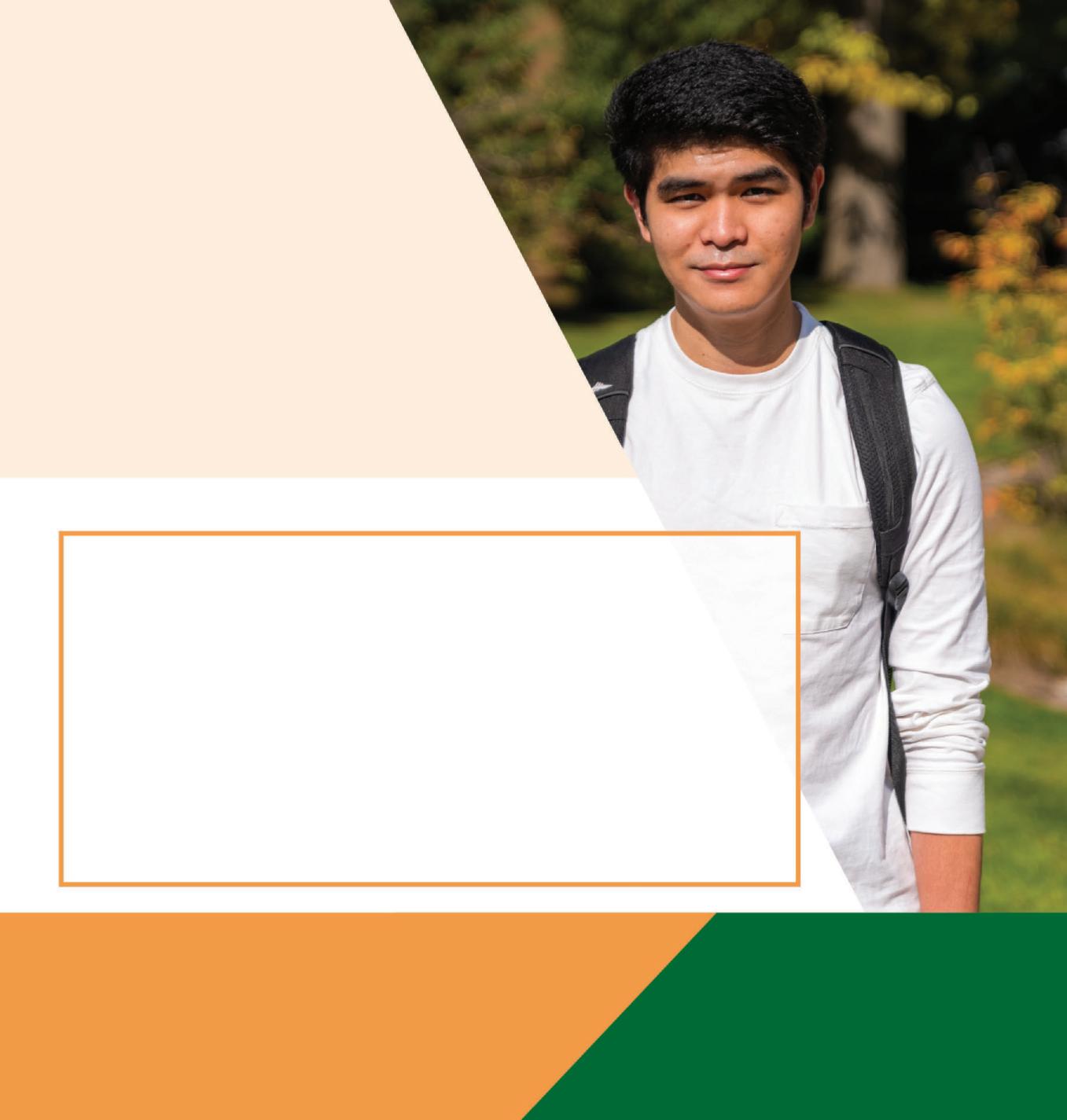
Save more than $22,000* when pursuing a 4-year degree
Financial aid and more than $500,000 awarded scholarships each year
Personalized instruction from faculty with real-world experience

Earning a four-year degree is one path toward a rewarding career. However, that path is the only one available to aspiring professionals. Enrolling in a vocational program can provide students with the skills necessary to engage in high-demand and wellpaying jobs.
Vocational school, often referred
A 2018 poll from The Learning House, a skills training and coursework company, found 35 percent of students said tuition and other fees were their primary concerns when choosing college programs. Trade schools can cost three times less than other schooling, making them more palatable to young people concerned about the high costs of college.
to as “trade school,” can be an advantageous route for many people who are looking for an alternative to college. In 2020, the National Center for Education Statistics said a four-year private college cost around $50,300 for a student living on campus, while a four-year public college was roughly $24,300 annually.
Career and Technical Education programs number around 1,200 in the United States alone. Many students begin vocational career tracks in high school, according to American Education Services. Here are some benefits to pursuing an education in the trades.
• Lower cost: According to NCES, trade schools cost significantly less than four-year institutions. Data from the U.S. Department of Education says programs may run between $3,600 to $16,000 per year. Most vocational

programs last two years, meaning that students graduate with far less debt than they might accrue when pursuing a fouryear college program.
• Individualized attention: Many trade programs offer instruction in very intimate settings, with experienced practitioners serving as mentors and trainers. While each program is different, vocational training schools tend to have lower faculty-to-student ratios than traditional colleges.
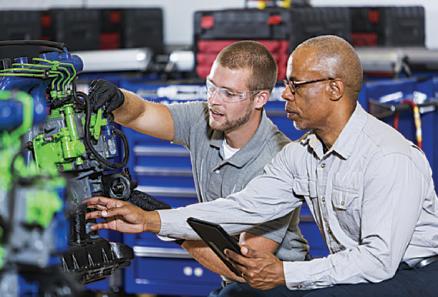
general education courses with those specific to a major, trade school programs focus only on skills and training relevant to each student’s chosen career path.
• Fewer admission requirements: Trade schools may not have the same stringent application and admissions processes as colleges. Course prerequisites and grade point average requirements also may not dictate trade school admissions policies.
• Direct, hands-on training: Unlike a traditional college that marries
• Less time to complete schooling: More direct lessons means that students can complete their certifications or degrees in shorter times and enter the workforce much more quickly than their counterparts at traditional colleges and universities.
Vocational training in trade schools is a viable option for students who want to spend less money and gain valuable skills they can utilize to earn a good living.


The world needs university students and young professionals to fill the talent gap. According to PMI’s 2021 Talent Gap: Ten-Year Employment Trends, Costs, and Global Implications report, the global economy needs 25 million new project professionals by 2030. To close the talent gap, 2.3 million people will need to enter project-management-oriented employment every year just to keep up with demand.
The local West Michigan Project Management Institute (WMPMI) Chapter fills the talent pipeline through a collegiate competition known as THEProject 2024! Get connected to WMPMI and industry leaders from a variety of professions in the workforce to move your career forward.
Who: University Students and Faculty
What: THEProject 2024 Collegiate Competition
Where: The Pinnacle Center 3330 Highland Drive Hudsonville, Michigan, 49426 When: April 8, 2024





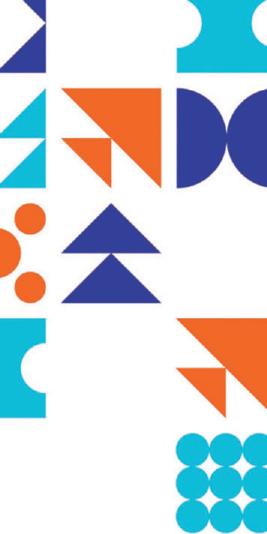


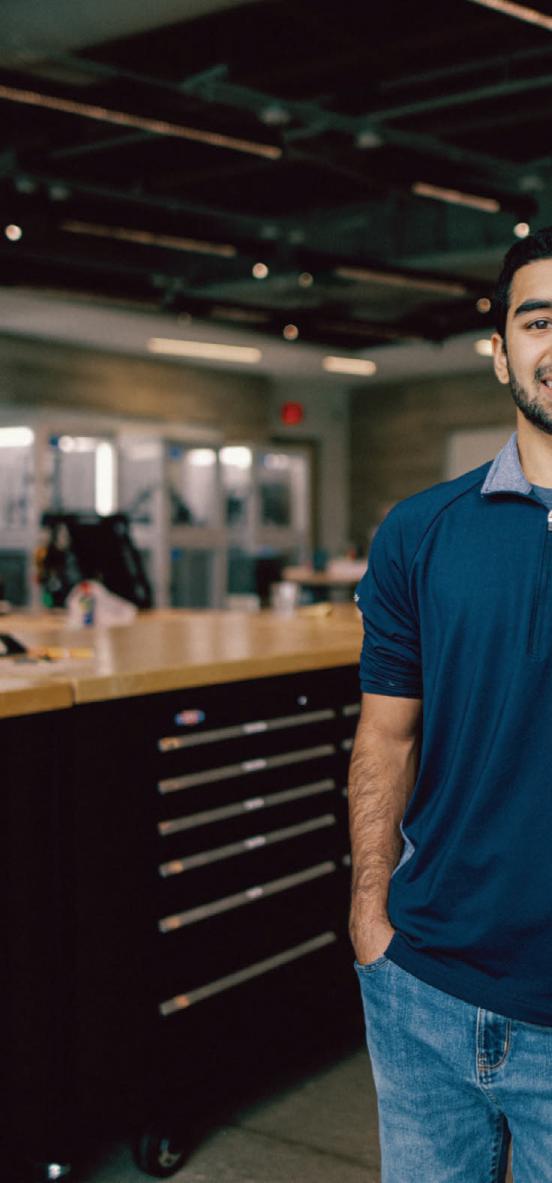



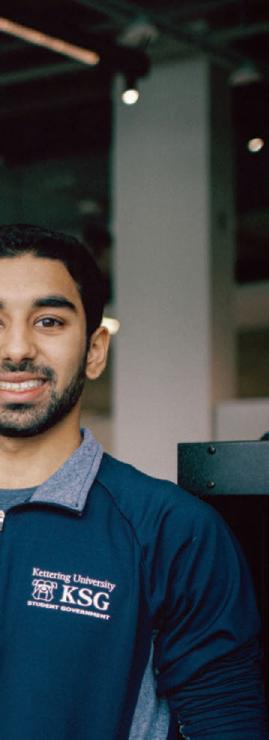


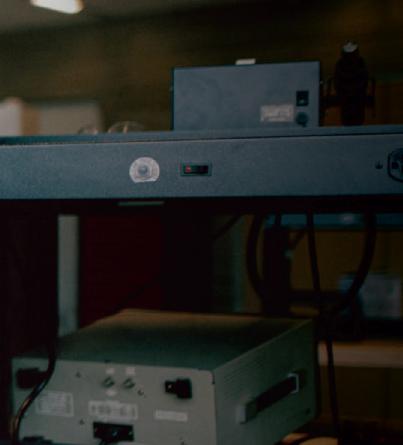
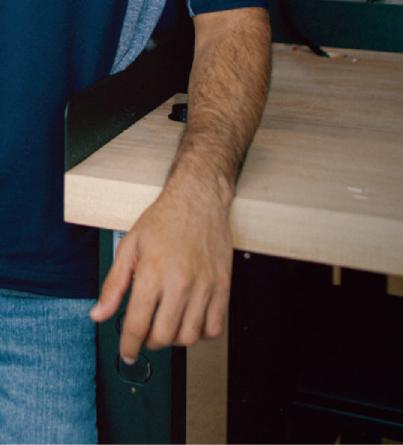
Kettering equipped me to succeed faster than my peers at other schools. It tested me academically and pushed me to turn aspirations into tangible achievements.
VARUN RALLABANDI ‘25
MAJOR: Computer Science
CO-OP: Lab2Fab, Fremont, CA
ORGANIZATIONS: Vice President Student Government, Phi Delta Theta Fraternity, Robot Honor Society
ACHIEVEMENTS: Two provisional patents
Not everyone splits their time between cutting-edge research in Michigan and high-level strategy sessions in California. Not everyone patents robotic solutions for household brands and pitches their ideas to CEOs — before they graduate.
But Bulldogs do — because their Kettering experience is like no other.



Tall strands of wild rice in Nottawa Creek are nourishing a partnership between Albion College and the Nottawaseppi Huron Band of the Potawatomi tribe in Michigan’s Calhoun County.
“The rice is a part of our connection to the land. It’s about our values and culture,” said elder and Nottawaseppi Tribal Historic Preservation Officer Doug Taylor.
Known to Anishinaabe people as manoomin, or “the good berry,” this aquatic plant has nourished Indigenous peoples of the Great Lakes, both physically and spiritually, for generations.
Once widespread, manoomin in
Michigan was nearly eradicated by White settler activities. Today, all 12 of Michigan’s federally-recognized tribes are working with state, federal, and regional partners to restore and preserve the sacred plant.
“We have very vigorous manoomin beds here, but we are still learning a lot about the science,” Taylor said.
In 2020, Dr. Allison Harnish, associate professor of anthropology at Albion College, contacted Taylor and John Rodwan, environmental director for the tribe, to propose a collaborative research project focused on manoomin restoration. The group was joined by Dr. Abigail Cahill, an associate professor of biology at Albion who studies aquatic macroinvertebrates – worms, leeches, snails, crayfish, and insect larvae
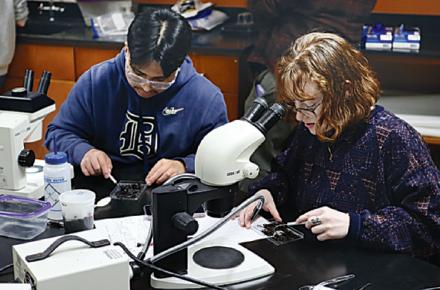
found in healthy water ecosystems.
At the time, Cahill was supervising the honors thesis research of Jess Garcia-Lopez ‘22, who found macroinvertebrates were more biodiverse in areas of the Kalamazoo River where manoomin grows. This result seemed to corroborate Indigenous knowledge about the importance of wild rice for overall ecosystem health.
The research was exciting, but “Doug and John challenged us to build a macroinvertebrate collector out of locally-available, biodegradable materials, rather than plastic, which contains harmful chemicals and contributes to global pollution problems,” Cahill said.

Cahill, Harnish, and several students experimented with making the containers from pine needles, deer hide, and birchbark.
“We were adapting technologies traditionally used in the manufacturing of birchbark canoes for a new purpose,” said Harnish. “But, we were worried about the bark retaining its shape when submerged in water and tossed by currents, and we weren’t confident in our ability to weave the screens on a large scale. We’d also been thinking we needed to reproduce the rectangular shape of the plastic collector, until John showed us a picture of a cylindrical birchbark storage jar.”
That’s when the group realized they needed a sturdy, lightweight internal frame – provided by biology major Daniel Jeremiah ‘25, a junior from Nigeria who created it using Albion’s 3D printer lab. In place of plastic filament, Jeremiah’s design calls for a mix of wood

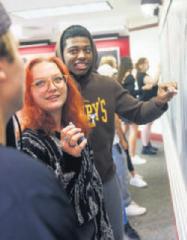
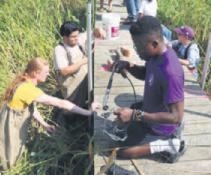
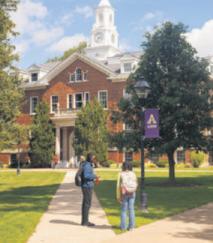




pulp and corn starch. The 3-D printed biodegradable frame is then wrapped in birchbark and tied with artificial sinew.
“We looked at a lot of bug catcher designs,” Jeremiah said. “We needed to incorporate natural ingredients that were strong and cost effective. We wanted to use birchbark, because that is culturally significant to Potawatomi people.”
Students in classes taught by Harnish and Cahill then got involved, assembling the collectors, placing them in the Kalamazoo and examining their contents. In September 2023, the research project expanded to Nottawa Creek, near the Nottawaseppi’s Pine Creek Reservation. The collector was also honored with the Potawatomi name wigwas-mkek (birch bark container). The team plans to release the 3D printer blueprint for the wigwas-mkek, to benefit others interested in similar restoration research.
The mutually-beneficial partnership
highlights the knowledge and worldview of the tribe while providing experiential learning and community outreach opportunities for students.
“We are producing knowledge for all of us to share,” Cahill said. “None of our students had met the tribe before, but the tribe has connected with them now. This is an opportunity for students to do very tangible work and handson learning that contributes to new knowledge that helps the tribe.”
Taylor added: “This project validates our life ways and values through science. It is providing education and experience to the students and brings to light that which has never been published. It makes the students the keepers of the subject matter. It helps us build a sustainability model that will help our people in the future.”

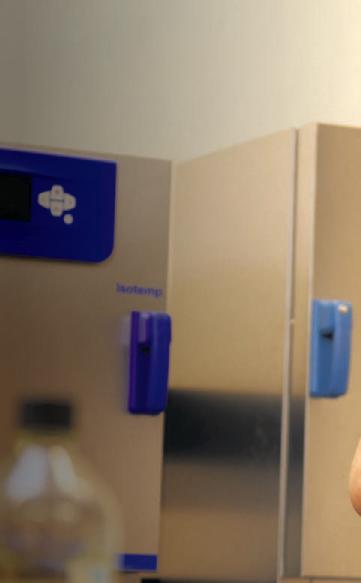


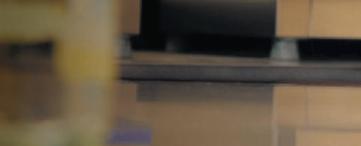
To be golden is to set the bar high, like IRENE GARCÍA DÍEZ. With the shining support of her OU professors and peers, she’s pursuing three majors, working as an intern and embracing roles as a leader, advocate, volunteer and mentor. Also looking to give back to others, Irene tutors Spanish-speaking students with an aim to improve their speaking proficiency and spark their interest in the importance of education. 10828849-04
We are changing the way the cost of education impacts students and their families, and have made a pledge to anchor tuition for each incoming class.
Affordability. Accessibility. Stability. These guiding principles led us to implement the Anchored Tuition Pledge, our assurance to hold tuition in place, at one rate with each incoming class. By “anchoring tuition,” our students pay the same tuition rate* for the duration of their education at Hope. The tuition rate they start with is the tuition rate they end with. We vow to hold your tuition rate constant because we are committed to the ambition of making Hope more affordable and accessible, both now and in the future.
*Room and board costs and other fees are not guaranteed from year to year and could vary with inflation.
Learn more at hope.edu/tuition
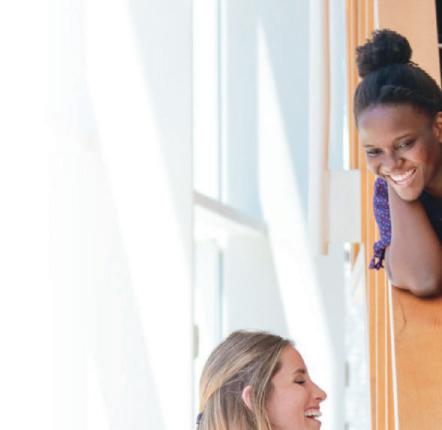


Choosing the right university can be overwhelming for high school seniors and their families. One crucial factor in the decisionmaking process is affordability. Paula Elenbaas, with nine years of experience in financial aid at Calvin University, offers six tips to help students and families navigate the financial aid process and make college education more affordable.
1. Ask the Right Questions
Narrow down your choices to 5-10 schools and review each one’s website for financial aid information. Look for scholarships, grants, and eligibility criteria based on your GPA or test
scores. For instance, at Calvin, a GPA of 3.0 or higher can qualify you for an academic scholarship ranging from $10,000-22,000. Check if you need to apply for financial aid and be aware of deadlines and requirements. Michigan residents at Calvin may be eligible for up to $7,000 in state grants.
2. Submit your FAFSA
To be considered for need-based financial aid, including grants and loans, submit a FAFSA (Free Application for Federal Student Aid) on studentaid.gov. Even non-U.S. citizens can use Calvin’s International Financial Form. The revised 20242025 FAFSA is streamlined with fewer questions and takes 5-10 minutes to complete. You can send it to up to 20

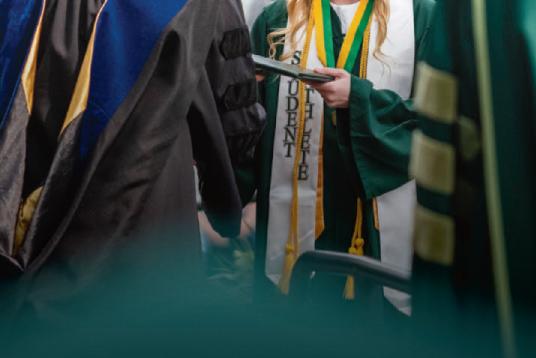

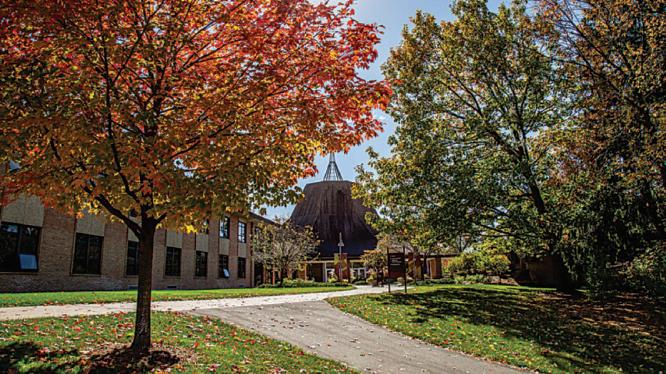
different colleges. It’s important to be aware that colleges won’t receive FAFSA data until Mid-March, delaying financial aid offers until late March or early April. While this may cause some anxiety, be assured that the delay will not impact your financial aid offer.
3. Apply for Scholarships
Create a list of colleges and visit those on your shortlist. Some colleges, like Calvin, offer incentives such as a $2,000 Visit Grant. Explore scholarship opportunities by visiting financial aid websites, paying attention to counselor
recommendations, and checking college emails. At Calvin, a single application allows you to apply for over 1,500 Named Scholarships each year.
4. Work to Cover Costs
Consider employment to build your resume and help cover college costs. Begin applying for summer jobs or internships in early spring, ensuring you have plans before spring break. Calvin University provides on-campus job opportunities, from lab work to medical research or leading campus
continued | pg 13



continued | from pg 12
tours. Working around 10 hours a week can earn you approximately $3,000 during the school year. Juniors and seniors at Calvin often secure well-paid internships, aiding both financially and in building a robust resume.
5. Be Patient and Informed
After applying for admission and financial aid, including Named Scholarships, enjoy your senior year and postpone your final college decision until you have all the necessary information. Calvin University generally aims to send complete financial aid letters by midto-late February, but due to FAFSA delays, it may be late March or early April in 2024.
6. Connect with Your Financial Aid Office Comparing financial aid
packages can be confusing. If you have questions, reach out to Calvin Financial Aid at finaid@calvin.edu. They are ready to assist and clarify financial aid details. Families facing unique circumstances affecting their ability to pay for college can use the Calvin Special Circumstances Form to explore eligibility for additional needbased grants based on their financial situation.
By following these tips, students and families can make informed decisions, maximize financial aid opportunities, and make their college education more affordable.
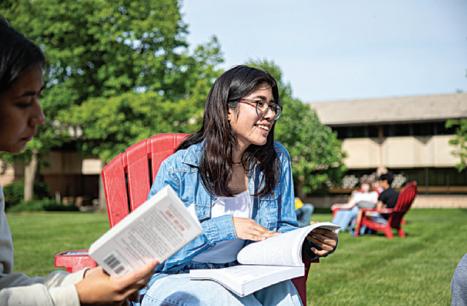
With more than 100 degree, professional certificate programs and short-term training opportunities, students can put their passion and skills together to build the future of their dreams. Classes are available online, in-person, or a mix of both. Start your educational journey at mcc.edu or by calling 810.762.0200.







At Calvin University, you can dream bigger. Think deeper. Aim higher. Become part of a university that challenges you to go beyond what you ever thought possible as Christ’s agents of renewal in the world. Learn more at calvin.edu/go-beyond.
MCC Title IX information can be found at: https://www.mcc.edu/titleix/index.shtml mcc.edu
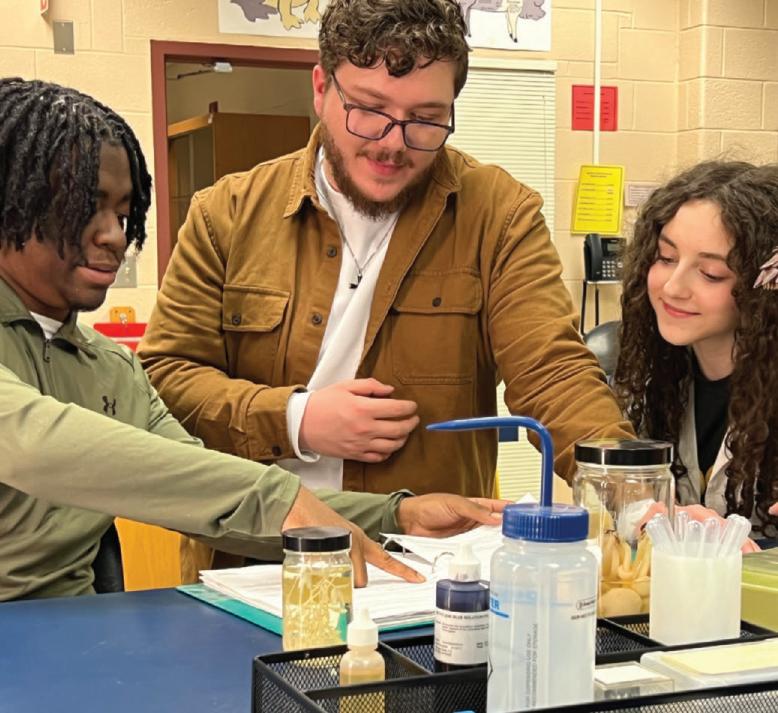


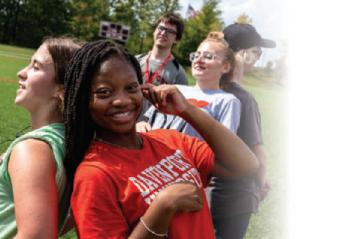
• 94% of graduates are employed within 6 months of graduation
• Michigan’s #1 safest campus*
• 48 athletic teams (26 NCAA Division II), plus all kinds of clubs and activities
• 100% of incoming freshman receive scholarships
• 16:1 student/faculty ratio
Individuals approach their careers in various ways. Some may aspire to climb the corporate ladder, while others may pursue a career that affords them ample personal time to spend how they see fit. Many individuals look for careers that afford them ample opportunities to work in the great outdoors, which could make the agricultural sector an appealing industry.
Talented individuals with an array of diverse skills dot the agricultural sector landscape, and the following are just a few of the many careers to consider within this vital industry.
• Equipment technician: Data from the career experts at Indeed indicates agricultural equipment technicians earn an average salary around $65,000

per yar. Agricultural equipment technicians maintain and repair existing machines and install new ones, among their many responsibilities.
• Purchasing agent: An agricultural purchasing agent buys products and raw materials at wholesale. Indeed
continued | pg 15
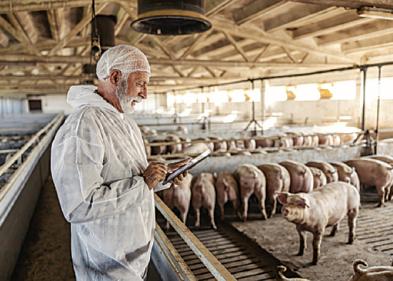
















notes that purchasing agents often must meet specific purchasing quotas for processors and work with various clients who supply an array of agricultural products. The national average salary for agricultural purchasing agents is around $51,000 annually.
• Warehouse manager: The receiving, shipping and storage of agricultural materials is overseen by a warehouse manager. Indeed notes that these professionals now routinely utilize artificial intelligence products to manage inventory. Warehouse managers must know and adhere to safety procedures and guidelines that dictate how materials and products are stored. The average salary of a warehouse manager is around $52,000 per year.
• Sales: Like every industry, the agricultural sector requires talented sales personnel. Agricultural sales reps sell materials and products and identify the needs of potential customers. Agricultural sales reps may
spend ample time on the road at trade shows. Doing so allows them to identify customers as well as their needs and wants, and promote their own products and services. An ability to foster strong and trusting interpersonal relationships is invaluable for agricultural sales reps, who Indeed reports earn an average of about $60,000 per year.
• Environmental engineer: Environmental engineers play pivotal roles within the industry, and could become even more vital in the decades ahead as the effects of climate change become more apparent. Environmental engineers design and implement solutions that occur on agricultural sites, helping to address issues such as unhealthy soil, insufficient drainage and inefficiencies, among other concerns. A career as an environmental engineer within the agricultural industry can be rewarding and lucrative, with Indeed noting that the average annual salary for this position is a little more than $77,000. These are just some of the career paths individuals can consider as they explore the agricultural sector.

Completing a college credential can mean:
• increased earnings and job opportunities,
• a brighter future for you and your family.
Jackson College offers in-person and online classes, affordable tuition, financial aid, excellent instruction and in-demand programs. Here you will find personalized support, on-campus housing, athletics, student life activities and more!
At Jackson College we are committed to your success. Get started today call 517.796.8425 or online at jccmi.edu.





For Grand Valley students, next is opportunity and innovation. Next is global, connecting and uniting us. It’s local, shaping the spaces in which we work and live. It’s a commitment to progress. Next is where minds are free to imagine what could be. At GVSU, next is now. And whatever’s next for you, we will help you get there.





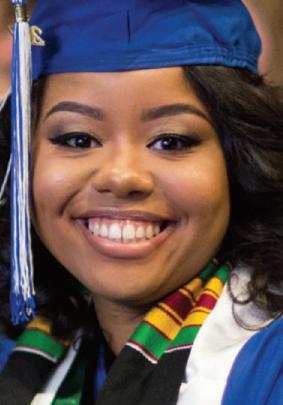







We deliver a transformational educational experience that helps students progress on their personal and professional journeys. With over 80 programs, flexible learning options, a transparent tuition structure, numerous scholarship opportunities, multiple locations, and FREE student housing on select campuses, Baker College makes it easy to find your fit.

Schedule a visit and apply today at baker.edu/apply

